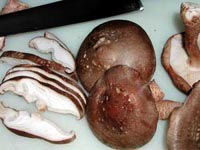Resource Library
Plant of the Week: Shiitake Mushroom
The University of Arkansas System Division of Agriculture does not promote, support or recommend plants featured in "Plant of the Week." Please consult your local Extension office for plants suitable for your region.
Plant of the Week
Shiitake Mushroom
Latin: Lentinus edodes

Strolling around the stalls of the Fayetteville farmer’s market, one finds a variety of items to nourish both the body and soul.
One of the items that show up with regularity of late is the shiitake mushroom, a tasty woodland morsel that is still new to many people. I’m especially pleased to see shiitakes on the tables because I and a couple colleagues had a small part in introducing this exotic crop into Arkansas.
Shiitake mushrooms are brown or beige with an earthy, mushroomy smell. They have round, recurved, 2- to 4-inch diameter caps with white gills beneath and a stout, somewhat woody stem.
They're a pretty mushroom, but if you are only accustomed to the white kinds, their coloration may be a bit off-putting.
From a flavor and texture standpoint, shiitake mushroom are more substantial than the typical white button mushroom. Because of their stronger flavor, most people eat them cooked. Their texture is more meaty than the typical mushroom, but not at all tough.
Some folks have likened the taste to beefsteak. Unlike the white mushroom that really has very little taste, shiitakes have a pleasant, nutty and perhaps slightly meaty taste that makes them great about any way you would want to prepare them.
Shiitake, also called the Japanese forest mushroom, is a wood decay mushroom that was introduced into the United States as a commercial crop about 1980. Gary Leatham, a forester in Wisconsin, first wrote on the mushroom in 1982 and aroused a lot of interest. In 1986, the late George Templeton (1931 - 1996), a plant pathologist at the U of A, approached me and Laurin Wheeler, a forestry colleague, about doing a series of educational meetings about this new crop.
Since I knew nothing about mushrooms, my job was to handle the logistics of organizing the meetings that we held across the state during the next couple years. Our expectations were modest because we did not anticipate the allure that an exotic venture can have on people looking for a get-rich-quick opportunity. Instead of the expected 25 or 30 people at the meetings, more than 300 attended.
Our message was to approach shiitake growing slowly and learn the technique first, and then only invest what you could afford to walk away from. But not all heeded the warning. High prices were being quoted for fresh mushrooms by gourmet restaurants - two or three times higher than the finest beefsteak. As with many new startup ventures, some of the first people to jump into shiitake growing were the first to fail.
As with many operations, it looked so easy. Drill a few holes in a log and then wait a year of so for the mushrooms to grow. Then wait for the money to come rolling in. But, as with all new industries there were problems. First, drilling 30 or 40 holes in 4-foot long logs was hard work.
More than one shiitake grower quickly developed forearms that Popeye would have envied. Secondly, the public didn’t know much about shiitake mushrooms and were slow to be convinced that these new exotic morsels were what they wanted.
But persistence - maybe stubbornness is a better word - pays. One of the people attending an early workshop was Tom Kimmons from Shirley. Tom saw the potential for shiitake production in the Ozarks and garnered some Economic Development money to support a training effort he developed in that community. Slowly, growers began to develop both the production techniques and a market for the mushrooms.
Few shiitake growers have made the proverbial killing off the mushroom, but a few have developed it into a small cottage industry. Many feel that mushrooms grown on oak logs are the best, but bag-grown mushrooms produced on oak sawdust are easier to produce and more predictable.
By: Gerald Klingaman, retired
Extension Horticulturist - Ornamentals
Extension News - September 12, 2003
The University of Arkansas System Division of Agriculture does not maintain lists of retail outlets where these plants can be purchased. Please check your local nursery or other retail outlets to ask about the availability of these plants for your growing area.